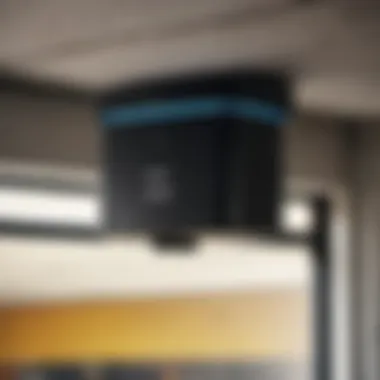Materials:
- Garage door panels: 3 panels, each measuring 8x7 feet
- Hinges and track system: Heavy-duty hinges and durable tracks
- Rollers: High-quality nylon rollers for smooth operation
- Springs: Torsion springs suitable for the weight of the door
- Opener system: Motorized opener with remote control
- Hardware: Bolts, screws, and brackets for secure installation
DIY Steps:
- Measure the garage opening accurately to determine the required door size.
- Select the appropriate material for the door based on durability and style preferences.
- Remove the old garage door carefully, ensuring all components are disconnected.
- Install the new track system, ensuring it is level and securely anchored to the wall.
- Attach the panels to the hinges, aligning them properly for a seamless look.
- Install the springs and tension them according to manufacturer guidelines.
- Connect and test the opener system to ensure smooth functionality.
Technical Aspects:
- Tools required: Tape measure, screwdriver, socket wrench, level
- Timing specifics: Allocate a full day for installation, including adjustments
- Critical techniques: Proper tensioning of springs, alignment of tracks
DIY Project Process:


- Begin by gathering all materials and tools in one place for easy access during installation.
- Start with assembling the door panels and attaching the hinges securely.
- Carefully install the track system, ensuring it is aligned and leveled throughout.
- Follow manufacturer instructions for spring installation, taking safety precautions.
- Program the opener system and test the door's operation before finalizing the installation.
- Troubleshooting Tips: If the door does not open or close smoothly, check for track misalignment or spring tension issues and make adjustments accordingly.
Factors Affecting Garage Door Costs


In the realm of home improvements, the cost of a new garage door and its installation is impacted by several key factors. Understanding these influences is essential for homeowners who are looking to undertake this project. By delving into material selection, insulation levels, design and style, as well as the size of the door, individuals can make informed decisions that align with their budget and preferences. Analyzing these factors not only helps in estimating the overall cost but also ensures that the chosen garage door meets both functional and aesthetic requirements.
Material Selection
When it comes to selecting the material for a garage door, homeowners are presented with a range of options each with its unique characteristics and considerations. Wooden doors, known for their classic appeal and natural warmth, offer a traditional aesthetic that complements various architectural styles. However, they may require more maintenance compared to steel or aluminum doors. Steel doors are valued for their durability and security features, making them a popular choice for those prioritizing strength and low maintenance. On the other hand, aluminum doors are lightweight, rust-resistant, and may be more suitable for modern design preferences. Each material choice brings its advantages and disadvantages, influencing both the cost and longevity of the garage door investment.
Insulation Levels
Considering the insulation levels of a garage door is crucial for maintaining interior comfort and energy efficiency. Single layer insulation provides basic thermal resistance, suitable for temperate climates where extreme temperatures are rare. Double layer insulation enhances thermal performance and noise reduction while triple layer insulation offers the highest level of energy efficiency and soundproofing. The insulation type chosen can impact the initial cost of the door as well as long-term savings on heating and cooling bills. Homeowners should weigh the insulation benefits against the upfront investment to determine the most cost-effective solution for their specific needs.
Design and Style
The design and style of a garage door contribute significantly to the overall aesthetic appeal of a home's exterior. Traditional designs, such as carriage house or barn-style doors, evoke a sense of timeless elegance and charm. Modern styles, characterized by sleek lines and minimalist features, offer a contemporary look that suits many modern architectural designs. Custom options allow homeowners to personalize their garage door design, reflecting their unique taste and preferences. Each design choice may have its advantages and disadvantages in terms of cost, maintenance, and curb appeal, making it important to select a style that aligns with the overall design theme of the home.
Size of the Door
The size of the garage door plays a critical role in the overall cost of the installation. Single car garage doors are typically smaller in width and height, suitable for accommodating a single standard-sized vehicle. Double car garage doors provide additional space for two vehicles, making them ideal for larger households or multiple-car owners. Custom sizes offer flexibility in door dimensions, allowing homeowners to tailor the door to fit specific garage requirements. Factors such as structural modifications, door opener compatibility, and aesthetic considerations can influence the choice of door size and the associated costs. Selecting the right door size is essential for ensuring functionality, convenience, and visual harmony with the rest of the property.
Installation Costs


When considering the cost of a new garage door and installation, one cannot overlook the crucial aspect of installation costs. This section sheds light on the significant impact that installation costs can have on the overall budget and planning of a garage door replacement project. Understanding installation costs is essential for homeowners looking to undertake this home improvement endeavor in a cost-effective and efficient manner.
Professional Installation vs. DIY
Benefits of Professional Installation
Professional installation offers a myriad of benefits that contribute to the smooth and successful completion of the garage door installation process. The key characteristic of professional installation lies in the expertise and experience that professional installers bring to the table. By opting for professional installation, homeowners can ensure precise and efficient installation, eliminating the risk of errors or structural issues that may arise from DIY attempts. The unique feature of professional installation is the assurance of quality workmanship and adherence to industry standards, ultimately guaranteeing a durable and reliable garage door system. While professional installation may come at a higher cost compared to DIY, the advantages of professional expertise and specialized knowledge make it a valuable investment for homeowners seeking a seamless installation experience.
Considerations for DIY Installation
While DIY installation may appeal to individuals looking to save on labor costs, it comes with certain considerations that should not be overlooked. The key characteristic of DIY installation is the opportunity for homeowners to take a hands-on approach to their garage door project, potentially saving money on labor expenses. However, DIY installation requires a certain level of technical skill and familiarity with garage door systems, making it a challenging task for beginners or those without prior experience. The unique feature of DIY installation is the sense of accomplishment and customization it offers, allowing homeowners to personalize their installation process according to their preferences. Despite its cost-saving potential, DIY installation may pose risks in terms of incorrect installation, voided warranties, and safety hazards if not executed correctly.
Labor Costs
Hourly Rates
Labor costs, particularly in terms of hourly rates, play a significant role in determining the overall expense of a new garage door installation. Understanding the implications of hourly rates is crucial for budgeting and planning purposes, as labor costs can heavily influence the total cost of the project. The key characteristic of hourly rates lies in the transparency and clarity it provides in terms of labor expenses, allowing homeowners to assess the cost-effectiveness of professional installation services. By evaluating and comparing hourly rates from different installation providers, homeowners can make informed decisions regarding their installation budget. The unique feature of hourly rates is the flexibility it offers in tailoring installation services to suit individual needs and budget constraints. While hourly rates may vary depending on the complexity of the installation task, they serve as a reliable indicator of the labor costs associated with a garage door replacement project.
Additional Charges
Apart from standard labor rates, homeowners should also consider additional charges that may arise during the installation process. These supplementary costs, which can include expenses for materials, permits, or unforeseen circumstances, contribute to the overall cost estimate of the garage door project. The key characteristic of additional charges is the necessity of accounting for potential hidden costs that may impact the budget for installation. By acknowledging and preparing for additional charges, homeowners can avoid financial surprises and ensure a well-managed installation budget. The unique feature of additional charges is the opportunity for homeowners to anticipate and plan for any extra expenses that may arise during the course of the installation, fostering a more organized and structured approach to budget management.
Additional Features
Windows
Windows are a popular additional feature that can enhance the functionality and aesthetic appeal of a garage door. The key characteristic of windows is their ability to introduce natural light into the garage space, making it a more inviting and visually appealing environment. By opting for windows in their garage door design, homeowners can create a seamless blend of indoor and outdoor elements, adding a touch of elegance and sophistication to their property. The unique feature of windows is the versatility they offer in terms of design options, enabling homeowners to customize their garage door to align with their architectural style and personal preferences. While the inclusion of windows may incur additional costs, the added benefits in terms of visual enhancement and increased property value make it a worthwhile investment for homeowners seeking to elevate the appearance of their home.
Insulation Upgrades
Insulation upgrades represent a valuable addition to any garage door, as they provide increased energy efficiency and climate control benefits. The key characteristic of insulation upgrades is their ability to regulate temperatures within the garage space, ensuring optimal comfort and energy conservation. By investing in insulation upgrades, homeowners can reduce heat loss in winter and heat gain in summer, leading to potential cost savings on heating and cooling bills. The unique feature of insulation upgrades is the soundproofing effect they offer, creating a quieter and more peaceful garage environment free from outside noise disturbances. While insulation upgrades may require an initial investment, the long-term savings and comfort improvements they provide make them a practical choice for homeowners prioritizing energy efficiency and environmental sustainability.
Smart Technology Integration
In the era of smart homes, integrating smart technology features into a garage door system can offer modern conveniences and enhanced security benefits. The key characteristic of smart technology integration is its ability to provide remote access and control of the garage door through smartphone apps or voice command devices. By embracing smart technology, homeowners can enjoy seamless operation of their garage door, monitoring its status and activity from anywhere at any time. The unique feature of smart technology integration is the customization options it offers, allowing homeowners to set personalized alerts, schedules, and user permissions for their garage access. While smart technology integration may come at a premium cost, the added convenience, security, and peace of mind it delivers make it a sought-after choice for homeowners looking to upgrade their garage door system to meet modern technological standards.
Budgeting and Planning Tips
Budgeting and planning are crucial aspects when considering the cost of a new garage door and its installation. This section aims to provide valuable insights into how proper budgeting and planning can make the process smoother and more efficient. By understanding the key elements and benefits of budgeting and planning, homeowners can ensure a successful and cost-effective garage door upgrade.
Researching Quotes
Multiple Quotes Comparison
Multiple quotes comparison is a fundamental aspect of the budgeting and planning process for a new garage door installation. By obtaining quotes from different providers, homeowners can compare pricing, services offered, and quality standards. This practice helps in making an informed decision based on cost-effectiveness and value for money. The key characteristic of multiple quotes comparison lies in its ability to offer transparency and options, allowing homeowners to tailor their choices to suit their budget and preferences.
Quality Assessment
Quality assessment plays a critical role in the budgeting and planning stage as it ensures that homeowners invest in a garage door that is durable, functional, and aesthetically pleasing. By assessing the quality standards of different garage door options, individuals can make informed decisions regarding long-term value and performance. The unique feature of quality assessment is its focus on longevity and reliability, minimizing the risk of unexpected repairs or replacements. While it may require a higher initial investment, prioritizing quality can lead to significant cost savings in the future.
Setting a Realistic Budget
Accounting for Unexpected Costs
Accounting for unexpected costs is a prudent approach to setting a realistic budget for a new garage door. By allocating a contingency fund for unforeseen expenses such as additional materials or labor, homeowners can avoid financial strain and project delays. This strategic planning aspect ensures that any surprises during the installation process are manageable without compromising the overall budget.
Allocating Funds Wisely
Allocating funds wisely involves prioritizing essential elements of the garage door and installation, such as quality materials and professional labor. By earmarking budget allocations for different project components, homeowners can maintain control over spending and maximize the outcome. The unique feature of allocating funds wisely is its focus on value optimization, ensuring that every dollar spent contributes to the overall quality and longevity of the garage door.
Scheduling the Installation
Lead Times
Lead times refer to the duration required from order placement to installation completion. Understanding lead times is essential for planning purposes, especially if time-sensitive factors are involved. The key characteristic of lead times is their impact on project timelines and coordination with other home improvement tasks. Homeowners benefit from timely installations, avoiding prolonged periods of inconvenience or disruptions.
Seasonal Considerations
Seasonal considerations play a significant role in scheduling garage door installations. Factors such as weather conditions and demand fluctuations can influence the optimal timing for this home upgrade. The unique feature of seasonal considerations is their ability to leverage peak seasons for promotions or to avoid peak times for smoother installations. By aligning the installation with the right season, homeowners can enhance cost-effectiveness and efficiency in the project.





